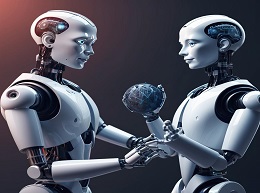The Relationship Between AI and Internet of Things (IoT)

Artificial Intelligence (AI) and the Internet of Things (IoT) are two transformative technologies that have revolutionized various aspects of our lives. While AI enables machines to simulate human intelligence, IoT connects physical devices and objects to the internet, creating a network of interconnected devices. In this article, we delve into the symbiotic relationship between AI and IoT, exploring how these technologies complement each other and drive innovation in the era of connected devices and smart systems.
Understanding AI and IoT
Artificial Intelligence (AI)
AI refers to the ability of machines or computer systems to perform tasks that typically require human intelligence, such as learning, reasoning, problem-solving, and decision-making. AI technologies, including machine learning, natural language processing, and computer vision, enable machines to analyze data, extract insights, and make autonomous decisions without human intervention.
Internet of Things (IoT)
The Internet of Things (IoT) encompasses a network of interconnected devices, sensors, and objects embedded with internet connectivity, enabling them to collect, exchange, and analyze data. IoT devices span various domains, including smart homes, wearable devices, industrial equipment, healthcare devices, and environmental monitoring systems, among others.
Synergistic Relationship Between AI and IoT
The convergence of AI and IoT creates a symbiotic relationship that enhances the capabilities and functionalities of connected devices and smart systems. AI algorithms analyze vast amounts of data collected by IoT devices, extract meaningful insights, and enable intelligent decision-making and automation, driving efficiency, innovation, and value creation across various industries.
Example: Smart Home Automation
AI-powered smart home devices, such as smart thermostats, lighting systems, and security cameras, leverage IoT connectivity to collect data about users' preferences, behaviors, and environmental conditions. AI algorithms analyze this data to optimize energy usage, automate household tasks, and enhance security, providing users with personalized and seamless experiences.
Enhancing Data Analytics and Insights
IoT generates massive volumes of data from interconnected devices and sensors, often referred to as Big Data. AI technologies enable organizations to analyze and derive actionable insights from this data, unlocking valuable insights, patterns, and trends that drive informed decision-making and optimization in various domains, including healthcare, manufacturing, agriculture, and logistics.
Example: Predictive Maintenance in Manufacturing
In the manufacturing industry, IoT-enabled sensors collect real-time data about equipment performance, temperature, vibration, and other parameters. AI algorithms analyze this data to predict equipment failures before they occur, enabling proactive maintenance and minimizing downtime and operational disruptions, leading to cost savings and improved productivity.
Real-time Decision-Making and Automation
AI algorithms embedded in IoT devices enable real-time decision-making and automation, empowering devices to respond autonomously to changing conditions and events. This capability is particularly valuable in critical applications such as autonomous vehicles, smart cities, healthcare monitoring systems, and industrial automation, where timely and accurate decision-making is essential.
Example: Autonomous Vehicles
Autonomous vehicles leverage AI and IoT technologies to analyze sensor data, such as GPS, lidar, radar, and camera feeds, to navigate and make real-time decisions on the road. AI algorithms process this data to detect obstacles, predict traffic patterns, and optimize driving routes, enabling safe and efficient autonomous driving experiences.
Challenges and Considerations
Despite the numerous benefits of the symbiotic relationship between AI and IoT, several challenges and considerations need to be addressed, including data privacy and security, interoperability, scalability, regulatory compliance, ethical implications, and the potential for bias in AI algorithms. Addressing these challenges requires a multidisciplinary approach and collaboration among stakeholders to ensure responsible and ethical deployment of AI and IoT technologies.
Conclusion: Unlocking the Potential of AI and IoT
The synergistic relationship between AI and IoT holds immense potential to transform industries, improve quality of life, and drive innovation in the era of connected devices and smart systems. By leveraging AI-driven insights and automation capabilities, IoT enables intelligent decision-making, optimization, and automation across various domains, paving the way for a more efficient, sustainable, and connected future.
In conclusion, the relationship between AI and IoT represents a convergence of intelligence and connectivity that reshapes how we interact with the physical world. As these technologies continue to evolve and mature, their combined impact will drive new opportunities, challenges, and possibilities for innovation and transformation across industries and society as a whole.